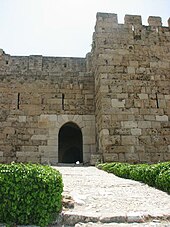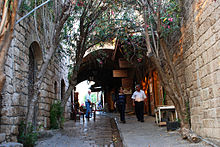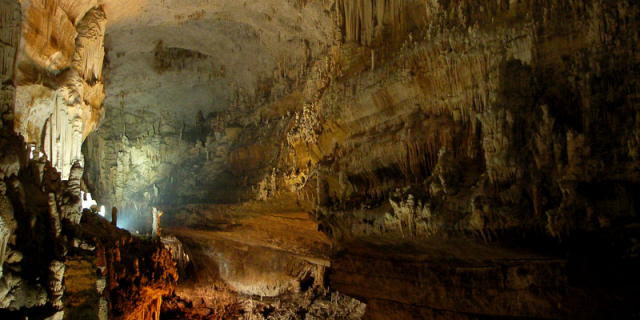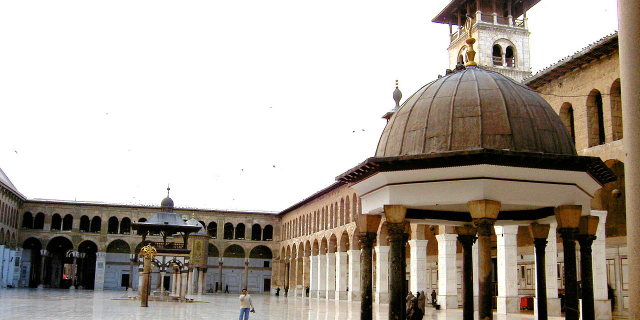Byblos ( BIB-loss; Greek: Βύβλος), also known as Jebeil, Jbeil or Jubayl (Arabic: جُبَيْل, romanized: Jubayl, locally Jbeil [ʒbeːl]; Phoenician: 𐤂𐤁𐤋, GBL, probably Gebal), is an ancient city in the Keserwan-Jbeil Governorate of Lebanon. The area is believed to have been first settled between 8800 and 7000 BC and continuously inhabited since 5000 BC. During its history, Byblos was part of nu...Read more
Byblos ( BIB-loss; Greek: Βύβλος), also known as Jebeil, Jbeil or Jubayl (Arabic: جُبَيْل, romanized: Jubayl, locally Jbeil [ʒbeːl]; Phoenician: 𐤂𐤁𐤋, GBL, probably Gebal), is an ancient city in the Keserwan-Jbeil Governorate of Lebanon. The area is believed to have been first settled between 8800 and 7000 BC and continuously inhabited since 5000 BC. During its history, Byblos was part of numerous cultures including Egyptian, Phoenician, Assyrian, Persian, Hellenistic, Roman, Genoese, Mamluk and Ottoman. Urbanisation is thought to have begun during the third millennium BC and it developed into a city making it one of the oldest cities in the world. It is a UNESCO World Heritage Site.
It was in ancient Byblos that the Phoenician alphabet, likely the ancestor of the Greek, Latin and all other Western alphabets, was developed.
 Terracotta jug from Byblos (now in the Louvre), Late Bronze Age (1600–1200 BC)
Terracotta jug from Byblos (now in the Louvre), Late Bronze Age (1600–1200 BC)Situated approximately 42 km (26 mi) north of Beirut, Byblos holds a strong allure for archaeologists due to its accumulations of various strata resulting from countless centuries of human dwelling. The initial excavation was conducted by Ernest Renan in 1860, documented in his work "Mission de Phénicie" (1865–1874). This was succeeded by Pierre Montet's efforts from 1921 to 1924, and later by Maurice Dunand, who continued excavations from 1925 for a span of forty years.[1][2] Renan's expedition was to "provide the evidence that the city did not move and that Gebeil is Byblos".[3]
Fragments attributed to the semi-legendary pre-Homeric Phoenician priest Sanchuniathon say Byblos was the first city erected in Phoenicia and was established by the god Cronus.[4] (Cronus was considered the nearest equivalent to the Canaanite Baal or Baal Hammon in the syncretising system used by the ancient Greeks and Romans.) According to the writer Philo of Byblos (quoting Sanchuniathon, and quoted in Eusebius), Byblos was founded by the Phoenician shrine god El, (whom the Greeks identified with their god Cronus). During the 3rd millennium BC, the first signs of a town can be observed, with the remains of well-built houses of uniform size. This was the period when the Canaanite civilization began to develop.
Pre-Pottery-NeolithicThe site first appears to have been settled during the Pre-Pottery Neolithic B period, approximately 8800 to 7000 BC.[5][6]
Neolithic and Chalcolithic levelsNeolithic remains of some buildings can be observed at the site. Jacques Cauvin published studies of flint tools from the stratified Neolithic and Chalcolithic sites in 1962.[7] Remains of humans found in Chalcolithic burials have been published by Henri Victor Vallois in 1937.[8] Tombs from this era were discussed by Emir Maurice Chehab in 1950.[9] Early pottery found at the tell was published by E.S. Boynton in 1960 with further studies by R. Erich in 1954 and Van Liere and Henri de Contenson in 1964.[10][11][12]
Five levels stratigraphyPrehistoric settlements at Byblos were divided up by Dunand into the following five periods, which were recently expanded and re-calibrated by Yosef Garfinkel to correlate with Tell es-Sultan (Jericho):
Early Neolithic (early phase) corresponding to the Pre-Pottery Neolithic B (PPNB) of Jericho, represented by plastered floors and naviforme technology, dated between 8800 and 7000 BC; Early Neolithic (late phase) corresponding to the PNA of Tell es-Sultan (Jericho) IX (also Yarmukian) between 6400 and 5800 BC, represented by pottery, sickle blades, figurines and small points; Middle Neolithic corresponding to the PNB of Tell es-Sultan (Jericho) VIII and represented by pottery, dated between 5800 and 5300 BC; Late Neolithic corresponding to the Middle Chalcolithic of Beth Shean and represented by pottery, stone vessels, silos, chamber tombs and seals, dated between 5300 and 4500 BC; Early Chalcolithic corresponding to the Late Chalcolithic of Ghassulian, represented by jar burials, pierced flint, churn and a violin figurine, dated to between 4500 and 3600 BC and, Late Chalcolithic corresponding to the Early Bronze Age, represented by architecture and cylinder seal impressions, dated to between 3600 and 3100 BC.[5]The Early Neolithic was a later settlement than others in the Beqaa Valley such as Labweh and Ard Tlaili. It was located on the seaward slope of the larger of the two hills that used to compose ancient Byblos, with a watered valley in between.[13]
 Dark faced burnished ware pottery from Shir, in Syria
Dark faced burnished ware pottery from Shir, in SyriaThe original site spread down into the valley and covered an area of 1.2 ha (3.0 acres) providing fertile soils and a protected landing place for boats. Dunand discovered around twenty houses although some of the settlement was suggested to have been lost to the sea, robbed or destroyed.[2][14][15][16][17][18][19] Dwellings were rectangular with plastered floors, pottery was usually Dark faced burnished ware with some shell impressions.[20]
The Middle Neolithic was a smaller settlement of no more than 0.15 ha (0.37 acres) adjacent to the older site. The pottery was more developed with red washes and more varied forms and elaborate decorations, buildings were poorer with unplastered floors.
The Late Neolithic period showed development from the middle in building design, a wider range of more developed flint tools and a far larger variety of pottery with fabrication including silica. The Late Chalcolithic featured developments of "Canaanean blades" and fan scrapers. Adult burials in jars started to appear along with metal in the form of one copper hook, found in a jar. Some jars were lined with white plaster that was applied and self-hardened after firing.[21] Copper appeared more frequently in the Late Chalcolithic period along with multiple burials in tombs and jar handles with impressed signs.[10]
 ByblosEarly Bronze
ByblosEarly Bronze
According to Lorenzo Nigro, Byblos moved from being a fishermen's village to its earlier urban form at the beginning of the third millennium BC.[22] Early Bronze Age remains were characterised by the development of Byblos combed ware and a lithic assemblage studied by Jacques Cauvin.[13][23]
Watson Mills and Roger Bullard suggest that during the Old Kingdom of Egypt and Middle Kingdom of Egypt Byblos was virtually an Egyptian colony.[1] The growing city was a wealthy one and seems to have been an ally (among "those who are on his waters") of Egypt for many centuries. First Dynasty tombs used timbers from Byblos. One of the oldest Egyptian words for an oceangoing boat was "Byblos ship". Archaeologists have recovered Egyptian-made artifacts as old as a vessel fragment bearing the name of the Second dynasty ruler Khasekhemwy, although this "may easily have reached Byblos through trade and/or at a later period".[24]
Middle BronzeObjects have been found at Byblos naming the 13th Dynasty Egyptian king Neferhotep I.
Late BronzeThe rulers of Byblos maintained close relationships with the New Kingdom pharaohs of Ancient Egypt
Around 1350 BC, the Amarna letters include 60 letters from Rib-Hadda and his successor Ili-Rapih who were rulers of Byblos, writing to the Egyptian government. This is mainly due to Rib-Hadda's constant pleas for military assistance from Akhenaten. They also deal with the conquest of neighbouring city-states by the Habiru.
It appears Egyptian contact peaked during the 19th dynasty, only to decline during the 20th and 21st dynasties. In addition, when the New Kingdom collapsed in the 11th century BC, Byblos ceased being a colony and became the foremost city of Phoenicia.[25] Although the archaeological evidence seems to indicate a brief resurgence during the 22nd and 23rd dynasties, it is clear after the Third Intermediate Period the Egyptians started favouring Tyre and Sidon instead of Byblos.[26]
Archaeological evidence at Byblos, particularly the five Byblian royal inscriptions dating back to around 1200–1000 BC, shows existence of a Phoenician alphabet of twenty-two characters; an important example is the Ahiram sarcophagus. The use of the alphabet was spread by Phoenician merchants through their maritime trade into parts of North Africa and Europe. One of the most important monuments of this period is the Temple of the Obelisks, dedicated to the Canaanite war god Resheph, but this had fallen into ruins by the time of Alexander the Great.
 Traditional Lebanese house overlooking the Mediterranean sea, Byblos. This house is within the antiquities complex and illustrates the modern ground level concerning excavationsIron Age
Traditional Lebanese house overlooking the Mediterranean sea, Byblos. This house is within the antiquities complex and illustrates the modern ground level concerning excavationsIron Age
In the Assyrian period, Sibittibaal of Byblos became tributary to Tiglath-Pileser III in 738 BC, and in 701 BC, when Sennacherib conquered all Phoenicia, the king of Byblos was Urumilki. Byblos was also subject to Assyrian kings Esarhaddon (r. 681–669 BC) and Ashurbanipal (r. 668–627 BC), under its kings Milkiasaph and Yehawmelek.
In the Achaemenid Empire (538–332 BC), Byblos was the fourth of four Phoenician vassal kingdoms established by the Persians; the first three being Sidon, Tyre, and Arwad.
Hellenistic rule came with the arrival of Alexander the Great in the area in 332 BC. Coinage was in use, and there is abundant evidence of continued trade with other Mediterranean countries.
 Phoenicia in late antiquity, from the Peutinger map
Phoenicia in late antiquity, from the Peutinger map Ruins at port.
Ruins at port.During the Greco-Roman period, the temple of Resheph was elaborately rebuilt, and the city, though smaller than its neighbours such as Tyre and Sidon, was a centre for the cult of Adonis. In the 3rd century, a small but impressive theatre was constructed. With the rise of Christianity, a bishopric was established in Byblos, and the town grew rapidly. Although a Sasanian colony is known to have been established in the region following the early Muslim conquests of 636, there is little archaeological evidence for it. Trade with Europe effectively dried up, and it was not until the coming of the First Crusade in 1098 that prosperity returned to Byblos, known then as Gibelet or Giblet.
Crusader, Mamluk, Ottoman period Crusader Fort
Crusader Fort The Crusades-era Church of St. John-Mark in Byblos
The Crusades-era Church of St. John-Mark in ByblosIn the 12th and 13th century, Byblos became part of the County of Tripoli, a Crusader state connected to, but largely independent from, the Crusader Kingdom of Jerusalem.
As Gibelet or Giblet, it came under the rule of the Genoese Embriaco family, who created for themselves the Lordship of Gibelet, first as administrators of the city in the name of the Republic of Genoa, and then as a hereditary fief, undertaking to pay an annual fee to Genoa and the church of San Lorenzo (Genoa's Cathedral).[27]
The Embriaco family's residence, the Crusader castle of Gibelet, along with the fortified town, served as an important military base for the Crusaders. The remains of the castle are among the most impressive architectural structures now visible in the town centre. The town was taken by Saladin in 1187, re-taken by the Crusaders, and conquered by Baibars in 1266, but it remained in the possession of the Embriacos until around 1300.
Having voluntarily surrendered to the Mamluks, the city was relatively spared from looting following its capture.[28] Its fortifications were subsequently restored by Baybars.[29] From 1516 until 1918, the town and the whole region became part of the Ottoman Empire.
Contemporary history Byblos Historic Quarter
Byblos Historic QuarterByblos and all of Lebanon were placed under French Mandate from 1920 until 1943 when Lebanon achieved independence. The 2006 Lebanon War negatively affected the ancient city by covering its harbour and town walls with an oil slick that was the result of an oil spill from a nearby power plant.[30] This, however, has been cleared and the coastal area has since then become a destination for beach goers, especially in the late spring and throughout the summer season.





























Add new comment